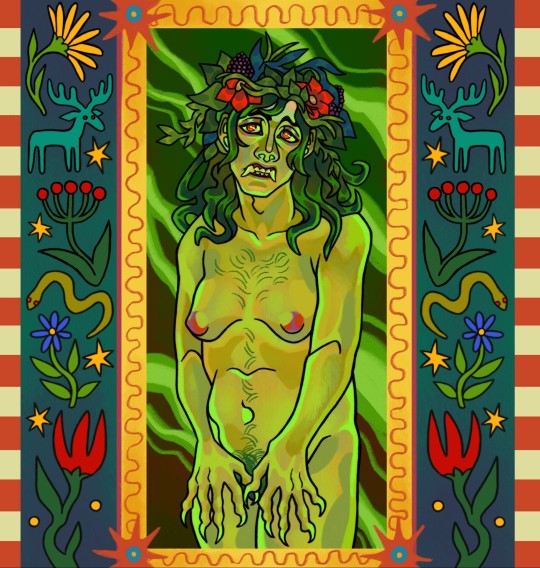this blog is dedicated to the lore and characters of zoreyar — a fictional fairytale fantasy world, set in the iron age. ¤ about the author: my name is varka or varja (any pronouns) and I am a 20 years old artist from ukraine, majoring in folklore studies. for other artworks follow @vyvilha
Last active 3 hours ago
Don't wanna be here? Send us removal request.
Text

The Noonwraith
80 notes
·
View notes
Text

Commissioned by @vyvilha theirs Serpent King. Illustration was Entirely based on a fantasy tale about @zorejar world.
35 notes
·
View notes
Text

valkarna, the daughter-god of nebokraj; lady of surreal, mistress of the grotesque
258 notes
·
View notes
Text

oc by the name of the grieving mother
179 notes
·
View notes
Text


cylegme with a crayfish by @devjjat
30 notes
·
View notes
Text

офелія смертельна ілюзія
розсипала лілії там де молюся я
76 notes
·
View notes
Text

the "we are going to beat you to death" lesbian polycule
83 notes
·
View notes
Text

dark-browed loverwoman
87 notes
·
View notes
Text


cylegme by swine_skin
44 notes
·
View notes
Text

witch girl, dark-eyed
the gods are cruel to you, aren't they?
199 notes
·
View notes
Text

in the folk beliefs of nebokraj, zemjeci are restless spirits of those who died after breaking a taboo against the earth. in their undeath, they are cursed to serve the serpent king for seven hundred years.
krajans beliefs are such: if one kills a snake during the snake festival, or in its sleep, or while the snakes are making love; or if one takes from the earth what they do not need during winter; or otherwise performs a harmful act to the land without giving anything in return; such people in their death become zemjeci.
while on their duty, zemjeci are denied entering the otherworld properly. they are one of many kinds of what nebokrajans call restless dead, or unclean dead — ones who after their death keep the ability to visit the living.
zemjeci are believed to care deeply for their still-living relatives, even trying to help them with husbandry and fieldwork. but such attempts often result in harm and mischief, for zemjeci, no longer being human, do not remember how to act human. their state is unnatural, and so the nature can not accept them. when a zemja tries to herd the cows, the herd, striken with madness, runs away, causing harm to themselves and others. when a zemja tries to weave, they do it backwards, spoiling the fabric. a zemja mother may try to lull her infant child, suffocating it in the process.
zemjeci work for the serpent king, whose husbandry is at the in-between. they herd his oxen, sew his clothes, clean his household, play with his kids. they can act as his messengers to the living. zemjeci are also believed to be tending the snakes, and are often euphemistically (so to not invoke them) called the serpent herders.
127 notes
·
View notes
Text

hurja the sun-faced on his wedding day
89 notes
·
View notes
Text

Nebokrajan legendary witch Anko with her firstborn child, a monstrous serpent whom she had with god Tzirašgohal.
Небокрайська легендарна відьма Анко зі своїм первістком: химерним змієм, що вона його породила від бога Цирашгохаля.
136 notes
·
View notes
Text

Nebokrajan wedding couple, wearing attire which resembles that of a cow-like goddess Tzaršee and her serpent spouse Khētakēl, who are believed to be the ideal of a marriage.
Небокрайські наречені, одягнені у костюми коровоподібної богині Царши та її чоловіка-змія Хетахеля, що вважаються ідеалом подружньої пари.
79 notes
·
View notes
Text

A fishwif, also called a fishmaiden, seamaiden or seawif, is a mythical creature known to people of Nebokraj and Soncejav. They are depicted as monstrous giantesses with fish-like or serpent-like features.
In yavitan tradition, fishwifs are believed to be the first people made by God, when the creation was new and the world was a never-ending ocean. He later abandoned them, for fishwifs didn't have a soul and were unable to create. It is said that when sailors pass them by, seamaidens ask them, weeping: "when shall Lord our God return to us?"
Seamaidens are a popular motif in yavitan art. Their depictions are used as apotropaic symbols, and fishwifs are frequently painted on doorways, baby cribs, dinner tables and temple walls. An aspect of yavitan God known as Lady of the Bones is strongly associated with sea and fish, and is sometimes imagined as having fish legs or emerging from a fish.
In krajan tradition seawifs are believed to be one of thirty three monsters born by the goddess Njarlanaj. Like most of the giants in krajan folklore, they are depicted as having golden skin — a color which is strongly associated with the otherworld.
Krajan goddesses associated with the sea, such as Maranval, Njarlanaj and Valkarna are often portrayed as seawifs.
A unique motif of a fishwif, known only to northern krajans is a "mournmaid" or "arysen" (from krajan "arys" — "grief, sorrow" and feminine suffix "-sen"). They are believed to inhabit lakes, ponds, springs and rivers, and their name comes from the calendar myth that every winter when the Sun dies and is later reborn, they mourn his death with loud weeping.
201 notes
·
View notes
Text

glawka by @vilha-alder
30 notes
·
View notes
Text

arysen by voblee on twitter
39 notes
·
View notes